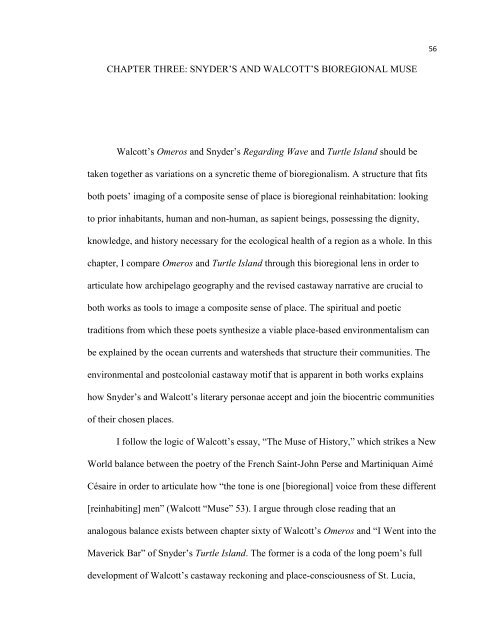RE-INHABITING THE ISLANDS - The University of North Carolina at ...
RE-INHABITING THE ISLANDS - The University of North Carolina at ...
RE-INHABITING THE ISLANDS - The University of North Carolina at ...
You also want an ePaper? Increase the reach of your titles
YUMPU automatically turns print PDFs into web optimized ePapers that Google loves.
56<br />
CHAPTER TH<strong>RE</strong>E: SNYDER‘S AND WALCOTT‘S BIO<strong>RE</strong>GIONAL MUSE<br />
Walcott‘s Omeros and Snyder‘s Regarding Wave and Turtle Island should be<br />
taken together as vari<strong>at</strong>ions on a syncretic theme <strong>of</strong> bioregionalism. A structure th<strong>at</strong> fits<br />
both poets‘ imaging <strong>of</strong> a composite sense <strong>of</strong> place is bioregional reinhabit<strong>at</strong>ion: looking<br />
to prior inhabitants, human and non-human, as sapient beings, possessing the dignity,<br />
knowledge, and history necessary for the ecological health <strong>of</strong> a region as a whole. In this<br />
chapter, I compare Omeros and Turtle Island through this bioregional lens in order to<br />
articul<strong>at</strong>e how archipelago geography and the revised castaway narr<strong>at</strong>ive are crucial to<br />
both works as tools to image a composite sense <strong>of</strong> place. <strong>The</strong> spiritual and poetic<br />
traditions from which these poets synthesize a viable place-based environmentalism can<br />
be explained by the ocean currents and w<strong>at</strong>ersheds th<strong>at</strong> structure their communities. <strong>The</strong><br />
environmental and postcolonial castaway motif th<strong>at</strong> is apparent in both works explains<br />
how Snyder‘s and Walcott‘s literary personae accept and join the biocentric communities<br />
<strong>of</strong> their chosen places.<br />
I follow the logic <strong>of</strong> Walcott‘s essay, ―<strong>The</strong> Muse <strong>of</strong> History,‖ which strikes a New<br />
World balance between the poetry <strong>of</strong> the French Saint-John Perse and Martiniquan Aimé<br />
Césaire in order to articul<strong>at</strong>e how ―the tone is one [bioregional] voice from these different<br />
[reinhabiting] men‖ (Walcott ―Muse‖ 53). I argue through close reading th<strong>at</strong> an<br />
analogous balance exists between chapter sixty <strong>of</strong> Walcott‘s Omeros and ―I Went into the<br />
Maverick Bar‖ <strong>of</strong> Snyder‘s Turtle Island. <strong>The</strong> former is a coda <strong>of</strong> the long poem‘s full<br />
development <strong>of</strong> Walcott‘s castaway reckoning and place-consciousness <strong>of</strong> St. Lucia,
















